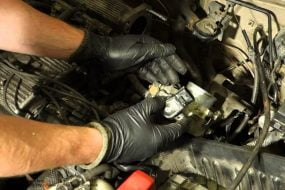
7.3 power stroke is a diesel engine known as Ford Motors and was first released in 1994. It is electronically controlled and said to be reliable. 7.3 power stroke was in use until 2003 when it was replaced with the 6.0 power stroke.
However, the question is, How many miles will a 7.3 powerstroke last?
On average, the 7.3 powerstroke can last between 400,000 to 500,000 miles if it’s well maintained. For the engine to cover enough miles there is a need to carry out routine check-ups and maintenance.
Is a Powerstroke Engine Reliable?
Powerstrokes are considered to be reliable depending on the year and model. Some are more reliable than others. The 7.3L powerstroke diesel engine is said to be one of the most reliable of the brand.
This is because the 7.3L power stroke diesel engine has a torque output of about 500-pound feet per second and the engine output is said to be about 235-pound feet per second. They are also considered to be quite powerful with its component built with an air-to-air intercooler.
According to the year and model, 1999 to 2001 is said to be more reliable and better than other models. These models are said to perform better because they do not have emission control therefore, the possibility of the engine failing is low.
The 6.7L power stroke engine of 2011 is also reliable due to its redesigning as opposed to the years between 1999 and 2011. The redesigning brought about an improvement in its performance.
Power strokes are said to be reliable for some of the following reasons;
- Long-lasting injectors
- The oil coolers are located outside
- It doesn’t have enough power to harm itself
- Lack of emission control in the engine
- Each cylinder has 6 bolts
- The engine design is very easy
- Geometry turbo is fixed
How Many Miles Will a 7.3 Powerstroke Last?
Getting an answer to this is quite subjective, however, a 7.3L Powerstroke has been the most reliable of its kind over time and is known to be able to last 500,000 miles with proper maintenance.
A lot of factors come to play in determining the miles a 7.3L power stroke would cover, factors such as; its usage, tuning, the climatic condition of the area of residence, etc.
Irrespective of some of these, a 7.3L power stroke should be able to last at least 150,000 miles and even under certain conditions 1.3 miles.
How to Make Your 7.3 Powerstroke Last Longer
It has been established that for a 7.3 power stroke to cover many miles you will need to take good care of it, but it is also important to put measures in place in order to ensure it lasts longer. Here are some tips you can use to make it last longer.
Use Only Recommended Oil
Engines are an integral part of a vehicle and should be treated as such. Only oil recommended for use in the 7.3 Powerstroke owner’s manual should be used or one recommended by the mechanic. By using only recommended oil you can be sure of the engine lasting long.
Regular Maintenance
Maintenance is very important for the vehicle as a whole and most definitely the engine. With regular maintenance, the vehicle can cover longer miles with an increased life span.
During routine car checkups, all parts of the engine should be checked and those parts that need fixing should be fixed.
Clean Coolant and Air Filter Regularly
Over time, the coolant and air filter can get contaminated by dirt, dust, etc., hence, the need to clean them out as often as possible. Dirt in an engine will cause damage to its part and may reduce its life span.
How Many Miles is Too Much for a 7.3 Powerstroke?
Although the 7.3 power stroke can go many miles, it is possible for it to cover miles that are considered to be too much. A 7.3 power stroke going over 250,000 miles will be too much so it’s better to keep the miles covered below 250,000 miles.
Pros of Using 7.3 Powerstrokes
Not only is the 7.3 power stroke reliable but there are also advantages of having one in your vehicle. Below are some benefits of using it;
1. Resale Cost is Higher
You can be sure to get a good and higher cost for the engine even after it has been used, however, getting a higher resale value depends on how the engine has been used and maintained over time.
2. It Does not Possess an Emission System
7.3 power stroke is known for its durability, this is because it does not have emission control. It is able to meet emission regulations by relying on the engine’s computer calibration in order to adhere to NOx standards.
3. The Injection System is Reliable
The 7.3 power stroke uses a Caterpillar-sourced HEUI injection system that has undergone a long period of research and development. Coupled with their reliability, the injection systems are also durable.
4. Cheaper Parts
If during usage some parts of the engine get damaged and require a replacement, you don’t have to worry. Replacing any part of the engine doesn’t cost much compared to others.
5. It has a Varying Production Year
Another advantage of using the 7.3 power stroke is because of its drivetrain specifications. This engine produced 215-275hp and 425-525lbs which made it one of the better diesel engines.
6. Higher Compression
7.3 power stroke has a higher compression ratio. The compression ratio is the difference in the volume of air inside the cylinder when the piston is either at the top or bottom.
A higher compression ratio equals more power and a lower temperature of exhaust gas. When the compression is high, less fuel is required for combustion because the air will be hotter.
Conclusion
It has been established that proper maintenance of the 7.3 Powerstroke engine will increase the miles it will cover therefore; it should be of utmost priority. Maintenance doesn’t have to be costly if it is timely.
Besides regular maintenance, there are other ways to make the engine last longer. In order to keep the 7.3 power stroke in good condition for longer, only recommended oil should be used.
Using a different oil in the engine can cause it to underperform with reduced fuel efficiency. Some benefits of using the 7.3 power strokes are; the higher cost of reselling, the cheap cost of buying damaged parts, etc.









